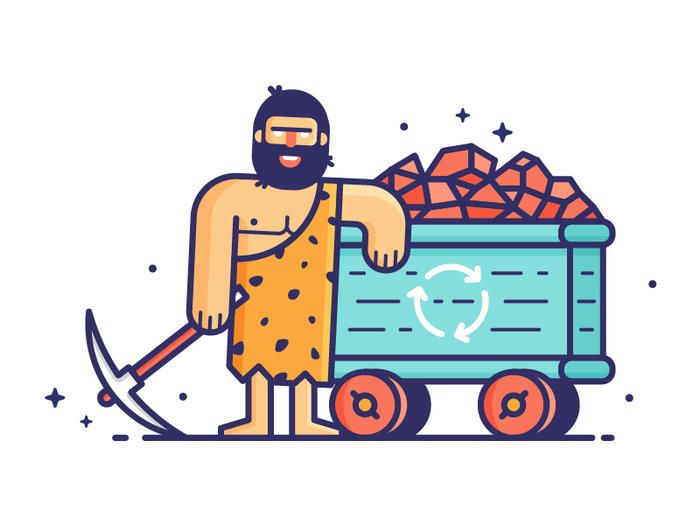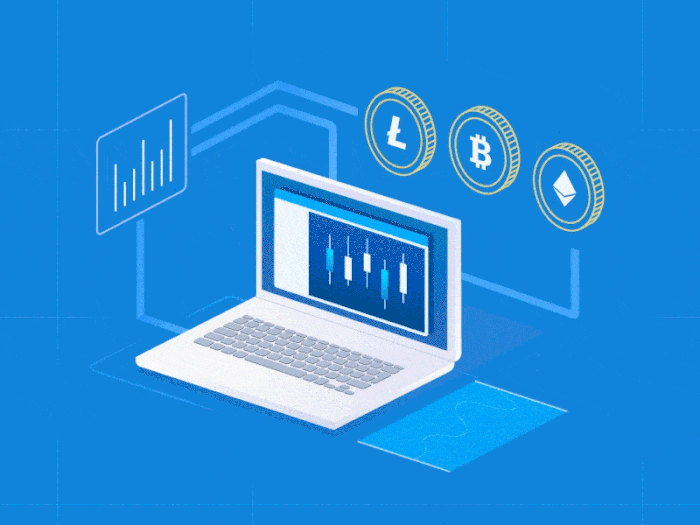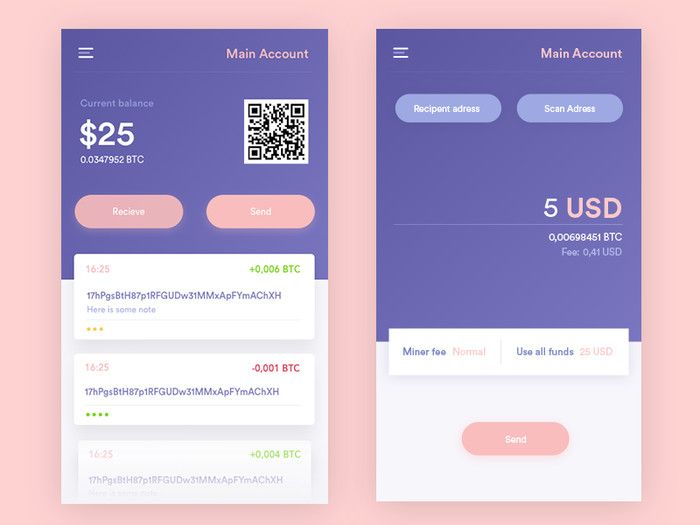Contents
How to Create a Bitcoin Wallet app?
Published: May 2, 2022
12 min read
In this article, you'll learn:
1
👨💻 Cryptocurrency, Bitcoin, Blockchain, Digital Wallets: Everything You Should Know about It
2
⚙️ Developing a Mobile Bitcoin Wallet: What is It and What Features should It Include?
3
🛠️ Technical Side of the Project: How Difficult is it To Build Such an App?
4
💸 How Much Does Bitcoin Mobile App Development Cost?
5
💡 Conclusion
Bitcoin, blockchain, mining… If these words sound like from a spy or science fiction movie, in this article we’ll lay it all out for you. Yet, if you’re already familiar with cryptocurrency, don’t rush to leave. Why? Cause today we’re going to learn how to build a digital wallet app!
If you’re a Discovery-lover or a fan of popular science channels on YouTube, you might have already seen at least one of many programs about the history of money. Actually, it reflects not only the giant leap that humanity made from a barter system towards coins, banknotes and then credit cards. It also indicates how economical relations between people looked like during different periods of time.

A prehistoric Bitcoin miner (image by Oleg Levin)
As you might guess, Bitcoin is a vivid example of another major shift in the world’s economy. Yet, for the most people cryptocurrency is still a pig in a poke. How does it work? Is it illegal? Where can I buy it? So that you never feel confused when talking about Bitcoin wallet development, we’ll try to get all the ducks in a row right now. Read on!
👨💻 Cryptocurrency, Bitcoin, Blockchain, Digital Wallets: Everything You Should Know about It
If you’re already familiar with all these concepts, and Blockchain or Bitcoin doesn’t sound like a secret hackers’ tool from a spy movie, feel free to scroll down to the paragraph about blockchain wallet development. Otherwise, keep on reading as we’re going to make everything clear and dispel all myths about this digital money system. Let’s start with basics!
What is Сryptocurrency? 💸
Firstly, you may think of it as an ordinary currency (like USD or EUR) but with 3 substantial features:
- It only exists in the digital/virtual form and can’t be printed or minted.
- The part “crypto” has nothing in common with aliens. It just denotes the use of cryptography to create a brand new level of security.
- There is no any central authority that can manipulate or interfere this currency since it’s not associated with any country or government.
Secondly, despite the status of cryptocurrencies is still mostly undefined, it’s mostly not illegal to use them. Why mostly? Cause I’m not talking about China and other countries with specific regulations of the digital sphere.

Cryptocurrency is a new financial trend now (image by Michał Roszyk)
As for the rest, it works like any other “traditional” currency: you can buy, sell or pay with it for any goods and services. Despite not all marketplaces and retailers already accept cryptocurrency, many big players (like Amazon or Expedia) have already “joined the game”. This change in the economy gained a wide public attention only a few years ago. However, the first decentralized cryptocurrency (and now you may be surprised) was created back in 2009. How was it called? Bitcoin!
Bitcoin, Blockchain & Mining: How Are These Three Connected? ⛓️
So, we already learned that Bitcoin was the first cryptocurrency ever. However, their number grows every day with a tremendous speed: for example, there were over 900 digital currencies in July 2017 but already over 1100 in September 2017. Yet, by the market capitalization Bitcoin is an undeniable leader with almost $64 billion of dollars. It’s followed by Ethereum, Dash, Litecoin and others. What do they have in common? They all are based on the blockchain technology that replaces the central authority!

Ethereum & Litecoin are the most popular cryptocurrencies after Bitcoin (image by SELECTO)
Blockchain is a kind of a public ledger or a database that stores information about all Bitcoin (or Ethereum, or Dash - each digital currency operates in a separate Blockchain) transactions on every computer connected to the network. So every time user buys, sells, sends or receives cryptocurrency, the evidence of this transaction can’t be changed or faked, as it’s confirmed by hundreds of thousands of computers around the world. The same computers store a lot of copies of this information - and it is available for viewing to any user at any time. So it can never be lost or faked!
One more thing that you could hear about, but which you never understood is mining. Unlike the mining of gold in caves centuries ago with the help of brute physical force, a modern variant of mining is the process of solving difficult math algorithms to confirm cryptocurrency transaction. If it’s done successfully, “miners” are rewarded with cryptocurrency of their Blockchain.
Yet, the age of “garage” mining is over and now it’s almost impossible to do this using only your PC. Why? Because they don’t have enough computing power. Moreover, this field is already occupied by industrial miners, who have the newest and optimally tuned equipment and the cheapest tariff for electricity.

The mining farm in North America. Are you ready to compete? 😉
This was a small dip in the subject by Stormotion team. If you want to learn more on this topic, I can advise you to read the following article.
So, I hope we managed to lay it all out for you. When you understand how the whole system works, it will be easier for you to make a сryptocurrency app. Now we’re going to review must-have features for such an application!
P.S. One more reason to create a Bitcoin wallet is because words "Blockchain" and "Bitcoin" do a magical effect on investors 😄
⚙️ Developing a Mobile Bitcoin Wallet: What is It and What Features should It Include?
Mobile banking has never been as popular as now. According to Statista, the number of users who actively access mobile banking services only in the USA reaches more than 110 million people. Take a look:

Mobile banking users
And it’s easy to explain! Today you don’t have to visit a bank, wait in line and fill in some papers to send money to your aunt who lives at the other end of the country. Nowadays it’s possible to send payments and manage your bank account with a few taps and even without getting up from the couch.
So, the app you’re going to build is some kind of a “banking app” but for the cryptocurrency. With its help users should be able to buy, send and receive Bitcoins as well as spend them for online shopping as simple as with usual money. Therefore, it defines the most important features for the MVP Bitcoin application development. Let’s review them!
# 1: Authorization 🔐
This feature is pretty well-known and used in almost any application, so I won’t spend a lot of time talking about it.

Make sure that the authorization process is secure (image by Sergey Pikin)
Just remember, that the sign-up/log in process creates the first impression. If it’s too slow or complicated users may abandon your app even before they enter it which will ruin your all others KPIs as well. So don’t take it lightly.
# 2: Improved Security 🛡️
When we’re talking about Bitcoin app development, perfect protection of users’ personal data is the crucial feature for such an application. Why? Because it doesn’t matter how fast and flawless the app works, how nice-looking and user-friendly its UI is and how many cool features your application includes - only one hack would be enough to destroy the reputation and get sued by users.
Moreover, one of the main features of cryptocurrencies is anonymity. Everyone can see what transactions were sent to a particular wallet, but at the same time it is impossible to know the real owner of this purse.
However, if the database of your users is stolen, the thieves will see the matching of users with their wallets that will destroy all anonymity.
Here are a few ideas that you can implement to improve security when you develop a Bitcoin wallet:
- Offer users 2-factor authentication. It may require confirming the login process with a mobile number, PIN or Touch/Face ID.
- Implement auto-logout feature. It’s a smart way to prevent anyone from using users’ digital wallets if the smartphone was lost or stolen.
- Make sure your app generates a separate public key for every transaction. With public keys created for every new transaction you build an additional level of protection against frauds and hacks.
# 3: Wallet 👛
We decided to gather all main features that are necessary to make a cryptocurrency app under one name - a Wallet. Think of it as app’s body since it allows:
- Buy or sell digital currency at the current exchange rate using connected PayPal or bank accounts, credit and debit cards.
- Send Bitcoins to other users and receive cryptocurrency from them.
- See your current balance and the history of transactions.

Example of a digitial wallet (image by CZECH)
No doubt, that if you make a Bitcoin wallet app this feature is the central one. Keep on reading, cause a little bit later I will share with you how to implement the Wallet from the technical perspective.
# 4: Conversion Rates 💱
Bitcoin exchange rate changes every day and over big periods of time the difference is more than significant:

Dynamics of the bitcoin rate
During one day or even several hours your purchase or sale can turn from super-lucrative to very unprofitable. That’s why you should develop a bitcoin app with built-in actual exchange rates.
Moreover, you can go even further and provide some additional functionality. For example, show users how conversion rates have increased or decreased since yesterday, over a week or a month. This will allow users to forecast further course changes and to exchange the cryptocurrency at the most favorable rate.
You may even try to predict the future rate using ML algorithms (although this is difficult because it is very volatile).
# 5: QR-codes for Fast Transactions 🤳
Frankly speaking, it’s possible to create a Bitcoin wallet app without this feature. However, users will appreciate if your application has one. Why? Because it makes transaction processes even easier!
All they have to do in this case is to scan a QR-code from the other smartphone. In this case, it’s impossible to make a typo, so you may be sure that your Bitcoins will be correctly delivered.
# 6: Book of Addresses 📔
This is a separate screen with the list of frequently used addresses. It’s especially important for those who are going to use the Bitcoin app for business.
Like the previous one, this feature isn’t a must-have for a digital wallet app (but expected by users). However, its development won’t take long and cost you much, so it’s better to add it to your app than not.
# 7: Merchant Services 🛍️
If you really want to build a digital wallet app that will beat expectations of users, a list of retail services is what you should definitely add to your application. Why? Because without it, your app is just a pocket where users can store, buy, exchange but not use their Bitcoins. But with the built-in retail services users will have much more reasons to use your app on a daily basis.
For this purpose, you have to develop a separate screen from which users can access online marketplaces, retailers and services (like Expedia, Dell, Amazon and others) that accept bitcoins.

Interactive map with merchants who accept Bitcoin (image by Christophe Kerebel)
Another way to implement this feature is through the map. It can be used to browse located nearby offline stores and restaurants where users can pay with Bitcoins. However, we didn't manage to find a single stock of APIs of such places, so you may face the need to compile it manually by yourself. But if you find it - please send it us, too ;)
Actually, you can combine both approaches for the better result.
# 8: Push Notifications 📳
When it comes to Bitcoin and money transactions, it’s important to always stay notified about what is happening in your pocket. And push notifications perfectly deal with it! They keep users informed about new transactions, accepted payments and so on.
Also, you can use push notifications to make users more engaged with your app. For example, send them a message if the Bitcoin exchange rate has significantly increased or decreased. Thus, they will be able to sell or buy currency with a maximum benefit.
As you can see, everything is much simpler than it seemed! Bitcoin application development doesn’t include any complicated features that are difficult to implement. However, what about the tech side of the development in general? That’s what we’re going to find out right now!
🛠️ Technical Side of the Project: How Difficult is it To Build Such an App?
Luckily for you, tech side of the Bitcoin app development isn’t too complicated. There are a few public libraries that can be used to create transactions on your server, implement standard functionality and synchronize with the Blockchain. For example, Chain-java and BitcoinJ libraries are suitable for this purpose.
Also, pay attention to popular SDKs. They can make development much easier too.
For example, Blockchain.Info offers developers a full stack of APIs. Blockchain Wallet API is the one you need. It gives you the opportunity to implement the main functionality of the Bitcoin mobile app: creating a personal wallet, handling payments and transactions, address management and so on.
BitcoinJ SDK is implemented in Java, yet, it’s possible to use it with other JVM-compatible languages (for example, JavaScript, C++ or Ruby). This SDK provides Bitcoin developers not only with the standard set of tools for sending/receiving cryptocurrency and checking the current balance. It may be also useful when you need to implement encryption.
Another advantage is the SPV mode. It allows to download and work with only a part of blocks from the blockchain. Taking into account that the full blockchain size is already over 100GB (and it doubles every year), you can save a lot of space on your server.
It’s also possible to use Coinbase SDK on BackEnd to create a Bitcoin wallet app. Official libraries are available for Java, Python and other programming languages. The main advantage of Coinbase SDK is support of other digital currencies (Litecoin and Ethereum).
💸 How Much Does Bitcoin Mobile App Development Cost?
When talking about development costs, you should clearly understand that the most expensive part here is BackEnd. Yet, in this article we've reviewed only the FrontEnd part so our rough estimate applies only to the client version of the app. Take a look:
Bitcoin Wallet App Features estimated in hours
Using React Native
Features | Hours |
|---|---|
1.Authorization | |
Login/Password | 35 |
2-Factor Authentication | 30 |
| 40 |
| 50 |
| 55 |
| 38 |
| 50 |
| 20 |
| 28 |
| 25 |
| 80 |
| 45 |
| 40 |
Total Hours | 560 |
Approximate costs | $22,400 |
Thus, cryptocurrency wallet development (its FrontEnd side) will take from 560 hours or from $22,400.
Note: we took an average rate of $40/hour but it depends on many different factors so don't think of it as the final price.
💡 Conclusion
As you may notice, in this article we did not mention the BackEnd part. Cryptocurrency apps have a complicated structure of server part, so each case requires an individual approach.
As for the FrontEnd part, its’ development is no rocket science. However, if you need help with your Bitcoin wallet app development - you know where to find us (it’s the nice button below 😉).
Was it helpful?
Read also

How to Create a Fitness App: Process, Costs, Estimates and Challenges

What is Prototyping in IoT and Some Practical Advice

What is IoT Device Management?
Our clients say
![Stormotion client Pietro Saccomani, Founder from [object Object]](/static/40e913b6c17071a400d1a1c693a17319/b0e74/pietro.png)
They make the whole business work for us, and their improvements are fundamental to our operations. They’re reliable, honest, and willing to try new things that will help us. We appreciate how flexible and easygoing they are.
Pietro Saccomani, Founder
MobiLoud
